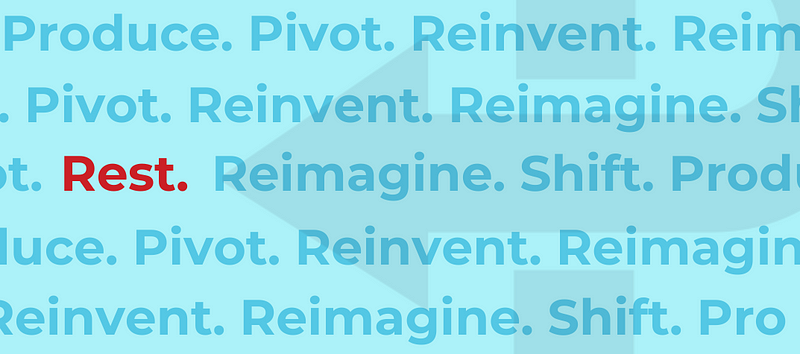Part 1. Designing for Access: Screwing Up and Starting Somewhere

Accessibility Cannot Be an Afterthought
Trying to increase your social impact (aka focus on humanity and the earth) while operating a business in capitalism is tough, but we have to start somewhere. There’s no switch to flip that will transition to an equitable economy overnight. We have to stop saying someday, and redesign the workplace now.
How can you ensure that anyone and everyone has the same opportunities, tools, experiences, and privileges as you do? ACCESS.
Access is a Human Right; it’s time we act like it. Human rights must be universal, or they’re not worth the paper they’re printed on.
This is why Accessibility is not one person's job. It should not be stuck in only one department. It's on all of us to put it in our jobs. Think of Access not as an add on, but an active removal of obstacles that prevent your information, or you, from reaching everyone else equally.
When we look at ACCESS—Who has it. Who needs it.—it reveals a lot about your workplace and company culture. People need to have access to something (an event, a service, a product, a place, a file, a drive, even the thermostat) in order to have the same opportunities and experiences.
Access is a Human Right; it’s time we act like it.
In order to increase access, everyone must work to remove barriers. We got this. To build sustainable, supportive companies, we have to work together.
Design on Purpose
Accessibility considered by everyone creates access for everyone.
If we leave Accessibility out only to redo or force it in later, odds are it will always be poorly done. Like any innovation, designing for access works best when embedded early and often in the design process. It's on everyone from the visionaries at the very beginning of the creative process to the production people at the end to consider accessibility.
This article, (from the collective Equity Meets Design) is a good primer, "Racism and inequity are products of design. They can be redesigned."
When I read it back in 2016 I found myself viscerally nodding.
Everyone is a designer and it's on everyone to consider equity. ✅
We all have biases that impact our creative process. ✅
Design can perpetuate inequality—and a lack of access—but like me, they see it as a tool for good. ✅
As any good social entrepreneur and designer worth their salt, their approach is systems based and holistic, and they review how to use design thinking as a tool to reduce implicit bias.
"Problem-solving is no longer about inventing things; it is about recreating systems. And in a world that continues to increase in complexity and technology, design thinking can simplify, humanize, and order this chaos."
To change the system, we first need to change who leads the design process and make it a collective endeavor. We can't wait for The Powers That Be to suddenly do the right thing or collaborate. We must use our power to close the gaps chasms of inequality ourselves. In Decentering the Designer, Betsy Ramaccia (Greater Good Studio) offers this:
“Whenever I’m trying to assess who has power over a process, I look for the decision making moments. Power and control manifest themselves most overtly during these moments, and as a design student, I was taught to hoard them to myself. Yet decision making in the practice of design is rarely a secluded experience.”
Ramaccia makes many other excellent points and it‘s something I’m constantly working on: to relinquish control as a designer to think I have THE way or answer. It’s hard! But it’s also obviously imperative to designing the Future of Work with accessibility at the fore.
EVERYONE is welcome in this work. As a signatory of The Design Justice Principles from DJN, Principle #6 states it beautifully. "We believe that everyone is an expert based on their own lived experience, and that we all have unique and brilliant contributions to bring to a design process."

Access is Everything.
We deserve the right to communicate and receive communications in a way that works for us. Accessible communications are imperative to transition away from extractive, imperialist BAU (business as usual) practices.
Access to information, access to resources, and access are all part of increasing visibility, decentralizing and sharing knowledge, and shifting the concentration of wealth and power to the 99%.
It’s not just physical. Access is more than a curb cut and ramp for a wheelchair. Accessibility is more than assistive technology (AT) (i.e. a screen reader for the visually impaired, captions for the hard of hearing, deaf, or someone with an auditory processing disorder).
It’s not just digital. Accessibility is more than the UX of a website or the look and feel. It's not only translation or readability.
Access encompasses language, costs, availability, and capacity. To transition to a Social and Solidarity Economy, we have to make sure that information is transparent, open source, affordable, and readable.
Reducing and removing barriers to access is important, but not just because you care about being a decent human, or building an inclusive business. It's also the law.
"The Americans with Disabilities Act (ADA) protects people with disabilities from discrimination" and is part of the U.S. Department of Justice Civil Rights Division. Even if the ADA may not apply to the size or type of business you have (yet), you don't want to discriminate.
"Inaccessible web content means that people with disabilities are denied equal access to information. An inaccessible website can exclude people just as much as steps at an entrance to a physical location. Ensuring web accessibility for people with disabilities is a priority for the Department of Justice."

If you want to go deeper...here's the info dump from the Feds.
If it's a priority for the DOJ, for civil-rights advocates, for social justice activists, and for anyone who cares about fairness at work, it's a priority for you, right?
Make it your business to keep learning about Design Accessibility. Care more. What we invest our time, money and attention in will inform the results.
Make it happen; make mistakes.
As my colleague Kara Smith says, if you’re not screwing up, you’re not on the court. When things are hard or we screw up she says, “This is when we know it’s working.” I love this simple shift to pushing ourselves to do things to make big moves, especially in our social impact.
A key way to increase your social impact (no matter what industry you are in or what you do) is by meeting digital design accessibility standards. Ensuring your content is accessible (in every sense of the word), is an easy way to start taking action TODAY.
You don't have to overhaul of compensation practices, or invent a new widget. Don't reinvent the wheel. (Social entrepreneurs don't do that anyway; it's a terrible waste of resources and energy!)
You don't need to go learn everything there is to know about living with disabilities, explore and test AT (Assistive Technology), read the Rehabilitation Act, and the Communications Act, assemble a design advisory board, or become a federally certified Accessibility expert.
Hey, you don't even need to read the full WACG 2.0 Digital Design Guidelines and get your small business in compliance with the ADA. State and local governments however have less than 2 years to get their websites up to date, 2026 or 2027, pursuant to the new DOJ rule to increase mobile access. (If that’s you, reach out here.)
What do you need to do? You need to be willing to fail.
Before you go any further, pause and embrace the idea that practice makes progress in design. You will make mistakes. So what? Mistakes make it happen.
Equity is a numbers game. Want more equitable businesses? How many more people can you reach, include, and serve?
It's very likely, if you have a website, you're already failing.
The majority, and I mean nearly every single website, fails global accessibility standards.
- 96.3% of homepages had detectable WCAG 2 failures. (WCAG is the federal government's standard).
- 90% are inaccessible to people using assistive technology (i.e. screen readers).
- On 84% of home pages, some or all of the text is too low-contrast.
- Almost a quarter of images are missing alt-text.
Basically, if you're failing accessibility compliance, you're in good company. No need to hide imperfections or pretend to be perfect. That's ableist anyway. It also means the bar is super low, and a low barrier to entry means it's easy to access. Win-win.
Design Accessibility is a process.
Everything is a WIP, including me and you.
While I don't consider myself a guru, I've come a long way in my knowledge and skills in designing for access. I've learned from and co-created with some of the best accessibility design experts and consultants in the world.
I design accessible digital products, websites, and content for myself and my clients. I've conducted brand audits and written inclusive content for organizations both big and small.
I partnered with Design Strategist and inclusion expert (and author of The Guide to Allyship), Amélie Lamont, to audit PeaceHealth’s new brand guidelines.
I’ve moderated panels and facilitated a dozen participatory design workshops, including a year long program for the Nebraska Department of Health and Human Services. One of the panels featured Global Accessibility Design practitioner and Creative Director, Jen Macias.
I even delivered a rad keynote with Kara Smith called "Pathways to Power: Transforming our Inner-state" on Design x Access, meant to empower everyone to remove barriers for others and see themselves as designers for access.
I co-host accessible online events, ran a global virtual conference, and I partner with clients for access for events in the built environment.
AND I started a community for neurodivergent and disabled creatives, caregivers—virtually.
Suffice to say, I have a solid amount of experience, and connections to the top talented humans who are leading design Accessibility.
And, here is my dirty design secret: (whispers) My primary business website, coflowco.com, is not fully accessible. (InfoDumpster.com is better, but not perfect.)
Shocked? Clutching your pearls? You shouldn't be. Remember, I said, almost every website is inaccessible? Remember how I said it's easy to screw up? Remember how I said, I am WIP, and always learning?
I built my site in 2019, and by 2020 had set my intention to make my site more accessible. I made some changes immediately, but it was last month, April 2024 (4 years late!), that I finally leveled up by publishing my own Web Accessibility Statement.
Until that point, the list of things I intended to fix on my site lived mostly my head. Solopreneurs and small businesses operate with limited capacity and cash, but using that as an excuse is a poor way to build "The Future of Work." It gives exactly 1 person, (me), access to that information, and an untold number of people are left out of learning about me and my work.
I could beat myself up, but why? I am not going to get everything right the first time. Only Tech Bros and Presidents think they have ALL the answers. (They sure don’t.)
One way social entrepreneurs can create more accessible businesses is to model what radical acceptance looks like. Focus on what's special and unique, and celebrate people's strengths. Like I said, I am really good at failing, I just don't let it trip me up. You shouldn’t either.
Instead, set your intention and chart your path to a more accessible, inclusive brand and business.
Here are a few things to keep in mind.
- Compliance in Design Accessibility is not a destination; it's a process.
- "Broken" is not bad. Not everything needs "fixing"–we just need to make sure we make it work for as many people as we can.
- Instead of deficits, consider we have differences. We need accomodations and assistance, not erasure or avoidance when we fall short or identify a flaw.
- Focus on strengths, and celebrate them (including your own). This is key to undoing ableist, capitalist, western thinking and working collectively to increase access and inclusion.
- Take it step by step, but don't limit yourself to accessibility design standards. Identify practical ways to improve your digital presence, including how you think about Designing a world that creates Universal Access.
We can always do better.
I said I fail forward, which means I know I have room for improvement.
Want to join me on my path to building more accessible social impact brands? You don't have sift through federal digital accessibility, or pay a fortune for a brand and digital overhaul just yet. (Of course if you want that level of support, you know who to call.)
Drafting a plan to make your website more accessible via a Website Accessibility Statements is a smart place to start.
The goal of a Website Accessibility Statement isn’t to show that you updated your site perfectly, but to acknowledge your site, like the majority of websites, is accessible, and a work in progress.
Only design justice and disability experts would model and encourage progress over perfection as beautifully as the living Website Accessibility Statement. It's very "meta" (self-referential) as the purpose of an "Accessibility Statement" is not to declare your greatness but to acknowledge that you're working on it.
When you're ready to level up, use the rad, easy AF, free tool I recently used to write coFLOWco's statement. Seriously, go use it now!
The most labor intensive part of creating your Web Accessibility Statement or policy is deciding to do it. Setting the strategy and vision for your inclusive brand is very straight forward. What will you fix soon? What might you do down the road?
Even if you "don't know what you don't know" you can still use the W3C Accessibility Statement Generator Tool, and say "I do not know." This is an emergent process, and your statement may be as simple as setting an intention to learn more.
If upgrading your brand, website, or business accessibility still seems daunting, remember, you will screw up. So? Show me a human who hasn't.
We all have to start somewhere. Start small. And you can always start by asking for help.







Member discussion